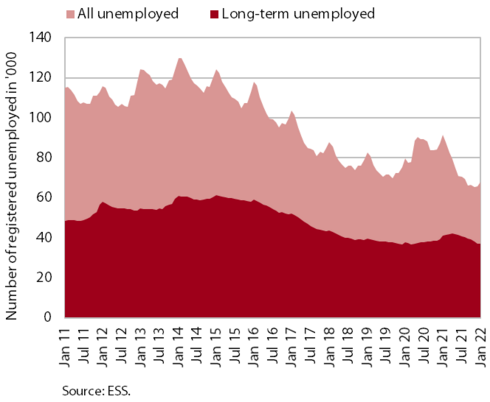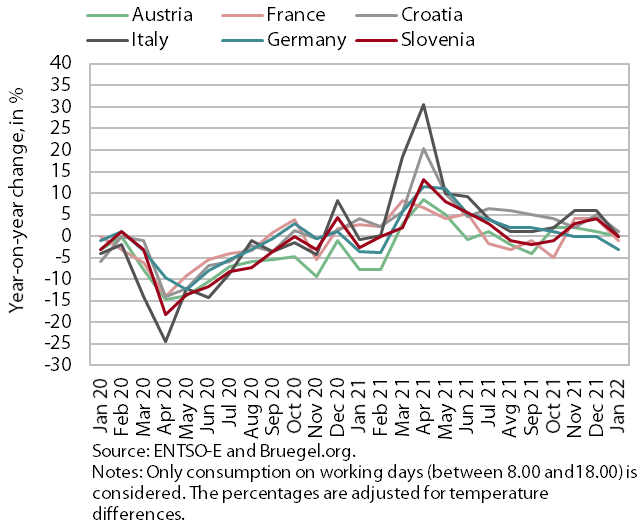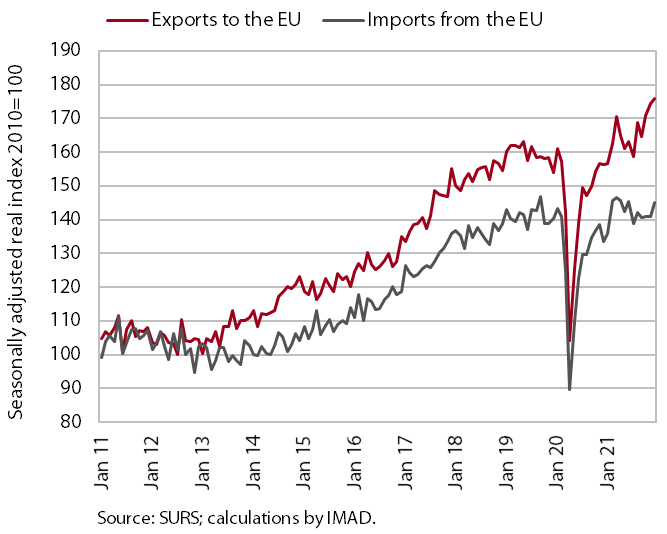Charts of the Week
Current economic trends from 31 January to 4 February 2022: registered unemployment, electricity consumption and trade in goods
Labour market conditions continued to be favourable in January and were mainly influenced by seasonal developments. The number of registered unemployed was lower than in the same period last year (by 25.9%) and lower than in January 2020 (by 15%). The number of long-term unemployed continued to decline in January and was lower than before the epidemic. Electricity consumption in January was about the same as in the same period last year, but 2% lower than in January 2020. Trade in goods increased in the last quarter of last year and was higher than in the same period of 2020, when it reached pre-epidemic levels. Slovenian companies' export expectations remain high and their monthly fluctuations indicate continued uncertainty, mainly related to the international environment.
Registered unemployment, January 2022

According to seasonally adjusted data, the number of registered unemployed persons fell further in January (by 2.6%). According to original data, 67,834 people were unemployed at the end of January, 2.8% more than at the end of December last year. This largely reflects seasonal trends related to a higher inflow into unemployment due to expiration of fixed-term employment contracts. The number of unemployed was 25.9% lower than last year and 15% lower than in January 2020. Among the unemployed, the number of long-term unemployed rose in the first four months of last year, but then fell again by the end of last year given the high demand for labour, which is also reflected in the high rate of job vacancies. The number of long-term unemployed continued to fall in January: by 10.4% compared to January last year and by 2.2% compared to the pre-epidemic period two years ago. Of the long-term unemployed, more than half have been unemployed for more than two years.
Electricity consumption, January 2022

Electricity consumption in January was about the same as in January 2021, but 2% lower than in January 2020. This is also due to the disruption of work processes related to absence of employees caused by the rapid spread of the Omicron variant. Similar trends can be observed among Slovenia's main trading partners. Compared to January 2021, consumption in January 2022 was about the same in Austria and Italy, while it was lower in Germany and France (3% and 1% respectively), and 1% higher in Croatia. Compared to January 2020, most of Slovenia’s partners recorded lower consumption, Austria by 4% and France, Italy and Germany by about 2%, while Croatia recorded 6% higher consumption.
Trade in goods, December 2021

Trade in goods increased in the last quarter of last year and was significantly above pre-epidemic levels. Compared to the previous quarter, real exports of goods rose strongly, especially real exports to EU Member States (6.8% higher, seasonally adjusted). According to the preliminary data, this was mainly due to the recovery of exports to Italy and Germany, while exports of vehicles also recovered slightly after a long period of decline. After a decline in the third quarter, imports from EU Member States also increased (by 1.6%, seasonally adjusted). Year-on-year, exports to and imports from EU Member States increased (by 11.4% and 4.2% respectively) and were also significantly higher than in the same period of 2019, with imports recovering more slowly than exports. At the beginning of this year, export expectations remain high and their monthly fluctuations point to continued uncertainty, mainly related to the international environment.
